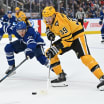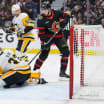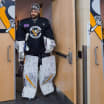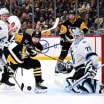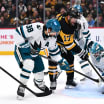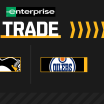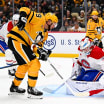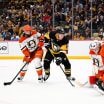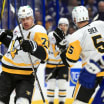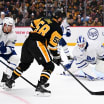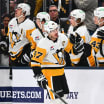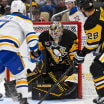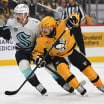Resilient Pens overcoming the odds
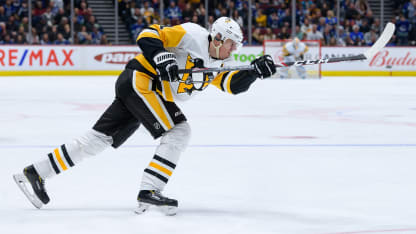
Pittsburgh has 25 wins and 55 points on the season. The 25 wins rank third (tied) in the entire NHL and second (tied) in the Eastern Conference. The Penguins' 55 point ranks fourth in the NHL and third in the East.
The Penguins have also established a home-ice advantage with a league-best 16-home victories and 16-5-3 mark.
Now, on-ice success is nothing new to the Penguins. They are the most successful NHL franchise in the salary cap era with three Stanley Cups championships, four Cup Final appearances, 13-straight playoff berths and 598-straight home sell outs.
And not to mention the 21 individual awards players have won in that time.
But what makes this current batch of Penguins so special is the adversity they've had to overcome this season to maintain their winning stature, particularly in the health department.
The Penguins have been decimated by injuries. They've racked up 173 man-games lost on the year through 42 games. But it isn't just the sheer amount of injuries, it's the injuries to key players.
Penguins captain Sidney Crosby has been out for the last 25 games after having surgery on a core muscle injury. Defensive stalwart Brian Dumoulin has been out for 18 games with a broken ankle. All-Star Jake Guentzel is out for 4-6 months after having surgery on his shoulder. Blueliner Justin Schultz missed the last eight games with a lower-body injury.
During the course of the year the Penguins have also lost Evgeni Malkin (13 games), Patric Hornqvist (17), Alex Galchenyuk (9), Kris Letang (8) and Jared McCann (2).
And yet, somehow, someway the team continues to thrive.
The Penguins went 10-2 in the month of December, the best record in the league.
"They're a great group of players. They have great character," head coach Mike Sullivan said. "We have great leadership. They're a resilient group. They believe they can win. I just think their stick-to-it-iveness is impressive. I think it starts with our veteran players. It starts with our leadership, and that just goes down the bench."
The keys to the Penguins' success have been pretty simple: resiliency and style.
Resiliency
Sullivan believes that part of the head coach's job is to steer the club's identity. But sometimes circumstances lead to an identity forming organically.
If we've learned anything over the opening half of the season, it's that the Penguins are resilient. They've faced obstacle after obstacle, and have never wavered.
The Penguins have been the embodiment of the "next man up." Pittsburgh iced a fully healthy squad for two periods (Nov. 2 vs. Edmonton). Seriously, two periods. All season. And Hornqvist suffered an injury in the third period of that game.
As one man goes down, another man steps up. Sam Lafferty and Joseph Blandisi, both of whom began the season in the American Hockey League with Wilkes-Barre/Scranton, have become regulars in the lineup. Adam Johnson, Andrew Agozzino and Thomas Di Pauli have all seen action.
On the backend, Chad Ruhwedel and Juuso Riikola, both of whom played limited games last year, have become the team's bottom pair with Schultz and Dumoulin out.
But it isn't just players stepping in that's made a difference, it's their contributions. The Penguins have spread their scoring throughout the lineup. Pittsburgh ranks seventh in the NHL in scoring (142 goals) even though Crosby, Malkin, Letang, Schultz and Hornqvist have missed significant time.
The Penguins are typically a top-heavy scoring team, with the bulk of its superstars leading the way offensively. Yet, only one player - Guentzel - ranks in the top-30 in NHL scoring. And still the Penguins rank seventh in the league.
In the absence of their top scorers, players like Rust (17 goals), Dominik Kahun (9), Brandon Tanev (8), Teddy Blueger (5), Zach Aston-Reese (5), Lafferty (4) and Dominik Simon (4) have been picking up some of the slack. Rust's goals stand out, but it's the culmination of all of their goals that have led to success.
And that success has bred confidence. There is a belief in the locker room that they can overcome any situation no matter how dire or who's in the lineup.
Behind 2-0 to Los Angeles? Penguins win 5-4 in a shootout. Trailing San Jose 1-0 and 2-1? Penguins come back to record a point in overtime. Down to a defensively structured Montreal team 1-0 and 2-1? Penguins come back to win the game in overtime.
"I love the resilience of the group," Sullivan said. "We've become a team. Guys have rallied around some of the adversity that has hit this club in the first half of the season. I just can't say enough about the players. They're working hard for one another. They're competing out there. Some nights it's not pretty, but we find ways."
Style
Traditionally, the Penguins are a team known for their flashy superstars and high-powered offense. But it's been the team's structured defense that has anchored their success so far this year.
The Penguins rank fifth in the NHL in goals allowed (113), and as a result are second (tied) in the league in goal differential at +29. Pittsburgh isn't just outscoring teams, it's out-defending them too.
These aren't your grandfather's Penguins. These aren't your father's Penguins. Heck, these aren't even your Penguins.
Goaltending has been a key factor with breakout star Tristan Jarry leading the way. Jarry leads the NHL in goals-against average (1.99), save percentage (.935) and shutouts (3), while rewriting the team's record for longest shutout sequence at 177:15 minutes. He was also named the NHL Second Star of the Month for December.
But a goaltender isn't the only part of being a good defensive team. It takes all five guys on the ice to buy in to being strong in the defensive zone. And while Sullivan may give credit to his players, it all starts with the head coach getting the team to buy in, and that buy-in happened almost right away.
On Oct. 10 against Anaheim, the Penguins grinded out a 2-1 victory without Malkin, Rust and Galchenyuk. They did so by playing hard in the defensive zone, playing within their structure, limiting turnovers, limiting odd-man rushes, outworking the Ducks and scoring a few opportunistic goals. That game became the blueprint of how the Penguins would play over the course of the year.
And a major factor in that play has been the team's work ethic. They can't always control when the puck goes in, but they can control how hard they work. Pittsburgh is a city built on blue-collar workers, and the team is now becoming an embodiment of the city.
The once flashy Penguins have embraced the lunch pail mentality.
"We are playing the game the right way, the way we want to play it," Sullivan said. "When we all buy in the way guys are buying in right now, we're a very good hockey team.
"I like where the mindset of the group is at right now. I give our players so much credit for how hard they're working. It's a collective effort. It's a team game in the true sense of the word."

